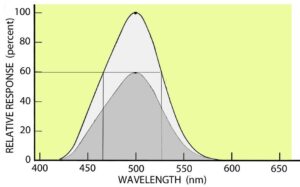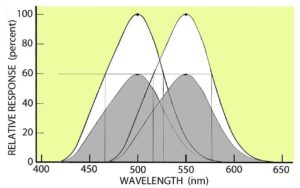Main Body
16 DISTINGUISHING PHOTON WAVELENGTH
(The “Glance” Gets Complicated) p. 53
Images are not just about distinguishing the shape of things out there in terms of the direction from which photons arrived. Being able to also distinguish their wavelength can provides lots of ”added value”. Again we take up the refrain: Which wavelengths get absorbed or emitted by a substance depends on its atoms.
What makes substances different is their atomic structure. Therefore different substances can be identified by which wavelengths they absorb or kick back out. Measuring those wavelengths enables determining the composition of that substance be it in a test tube, fruit hanging from the next tree, or a distant star – spectroscopy.
For this reason even primitive visual systems evolved means of distinguishing which wavelengths are reflected by a substance to sense its composition – initially to identify food. As more directional sensitivity evolved, distinguishing different substances also helped to sense the shape of things. (You may jump ahead for a peek at page 63, but come back.)
p. 54
Photons of different wavelengths could be distinguished by receptors containing molecules that absorb only one wavelength. Once selected by survival, response to that particular wavelength would require minimal information processing. However, adapting to other light conditions or different substances would require new genetic codes for other molecules to absorb new wavelengths – a slow process.
Having many different wavelength receptors would enable more adaptive responding to different substances in different lighting conditions. However, that creates a different problem. Being able to sense any of those photon wavelengths from each direction would involve clusters of receptors which together would have a much larger field of view (p. 39). The result would be a loss of directional acuity in proportional to the increase in spectral acuity.
An alternative approach has evolved that is based on photon receptors that respond to a wide range of wavelengths. These are then backed up by information processing to distinguish wavelength.
p. 55
Receptors with a molecule that reacts to a wide range of wavelengths can take advantage of more of the available light at any point in an image. Reacting optimally to a certain wavelength and less to others provides a limited ability to distinguish wavelengths. But not much. Here’s why:

In lots of light this receptor’s response is strongest to its optimal 500 nm wavelength and less to longer and shorter wavelengths (e.g., a 60% response to 465 and 535 nm). Though 465 and 535 nm would be indistinguishable.
Furthermore, the response to these wavelengths would be the same as the response to 60% less light at 500 nm.
p. 56
However, adding a second wide range receptor maximally sensitive to a different wavelength, does make it possible to distinguish the wavelengths to which they both respond:

The ratio of the their responses indicates wavelength regardless of the amount of light. The more precise those calculations the finer the distinction – and the more brain needed.For even better wavelength discrimination over a wider range most vertebrates (from fish to birds) have three or more types of such receptors.
However, most mammals have only two for daytimeconditions. (Why is also another story.14) For example, dogs have one receptor whose spectral sensitivity is veryclose to the one on the right in the above theoretical example – the other peaks at about 430 nm.
p. 57
Primates and squirrels are unique amongst mammals in having three types of broad spectrum daylight receptors. (Living in trees increased the survival value of better wavelength discrimination to recognize food in distant trees. Thereby they avoid descending to the ground, where they are vulnerable, and then having to climb again.)

Based on their spectral sensitivity range, these receptors are called SHORT, MIDDLE, and LONG wave- length cones – the latter from their shape:15
(Erudite readers never say blue, green, and red cones lest others think that they think the cones are colored by colored photons.)
The black function shows our ability to discriminate photons by wavelength based on hue.16
Note how the best discrimination occurs at wavelengths (480 & 575 nm) where the overlapping cone functions change most rapidly. (In these regions, small differences in wavelength result in large differences in the cone response ratios.) The average ability to discriminate differences of about 2 nanometers is consistent with our ability to distinguish over 100 different hues.
